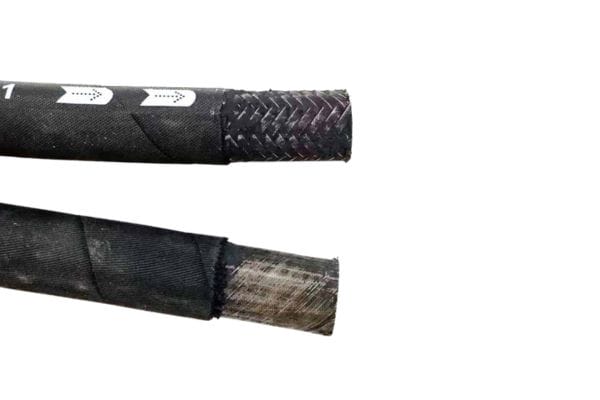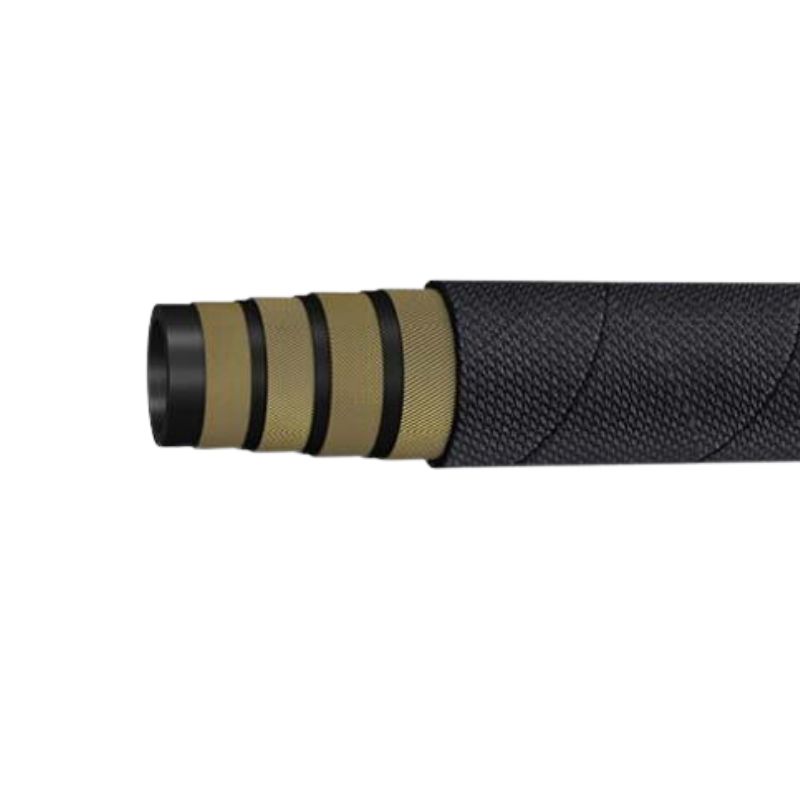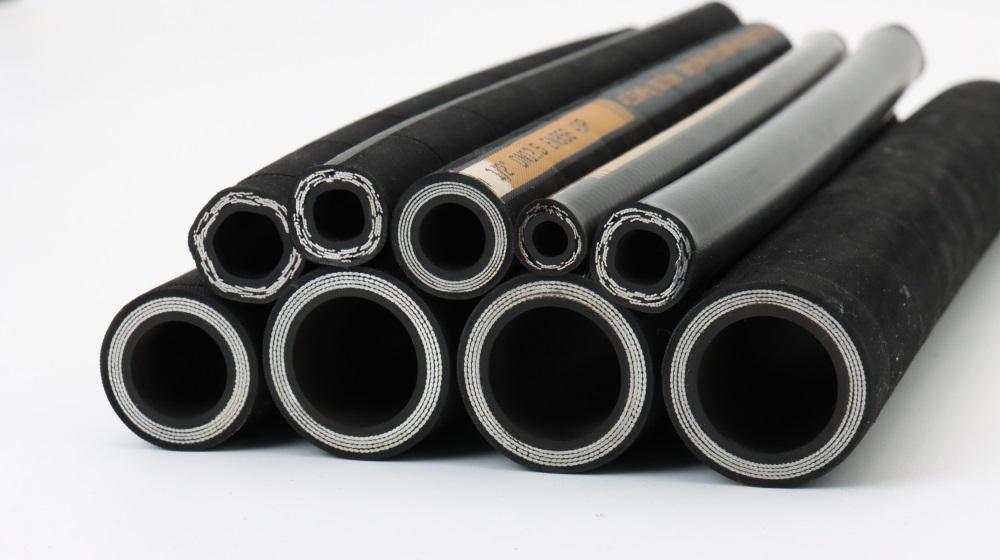In hydraulic systems, the hoses must be capable of withstanding high pressure and harsh operating conditions. They ensure the efficient transfer of power and control between different components, such as pumps, cylinders, and valves. The reliability of hydraulic hoses directly impacts the overall performance, safety, and longevity of the hydraulic system. By examining the construction, specifications, and performance of 4SP and 4SH hoses, this guide will help you understand their unique features and applications.
Understanding Hydraulic Hoses
What are Hydraulic Hoses?
Definition and Role in Hydraulic Systems
Hydraulic hoses are flexible, reinforced tubes designed to transfer hydraulic fluids within hydraulic systems. These hoses facilitate the movement of fluids under high pressure, enabling the operation of various hydraulic machinery and equipment. They are crucial for maintaining fluid flow between components such as pumps, cylinders, and valves, ensuring that the hydraulic system operates efficiently and safely.
Basic Construction and Types
A typical hydraulic hose consists of three main components:
Inner Tube: Made from high-quality synthetic rubber or thermoplastic, the inner tube is designed to handle the type of hydraulic fluid being transported, ensuring compatibility and preventing degradation.
Reinforcement Layers: Surrounding the inner tube, these layers provide strength and flexibility. They can include steel wire braids, spirals, or textile fibers, depending on the pressure requirements and hose type.
Outer Cover: The outer layer protects the hose from external damage such as abrasion, weather conditions, and chemicals. It is made from durable materials like synthetic rubber or thermoplastic.
Hydraulic hoses come in various types, including single-wire braid, double-wire braid, and multi-spiral, each designed for specific pressure ratings and applications.

Key Characteristics of Hydraulic Hoses
Reinforcement Layers
Reinforcement layers are critical for a hose’s ability to withstand high pressure and external forces. They provide structural integrity and flexibility, allowing the hose to handle dynamic movements and vibrations without failure. Common reinforcement methods include:
Braided Wire: Single or double layers of braided steel wire offer moderate pressure resistance and flexibility.
Spiral Wire: Multiple layers of spiral-wound steel wire provide higher pressure resistance and strength, ideal for more demanding applications.
Material and Durability
The materials used in hydraulic hoses impact their performance and longevity. Key factors include:
Inner Tube Material: The inner tube must be resistant to the hydraulic fluids it carries, with materials like nitrile, neoprene, or synthetic rubber being common choices.
Reinforcement Material: Steel wires or textile fibers in the reinforcement layers contribute to the hose’s pressure rating and flexibility.
Outer Cover Material: The outer cover should be resistant to abrasion, ozone, and weather conditions, with materials such as synthetic rubber or thermoplastic elastomers used to enhance durability.
Temperature and Pressure Ratings
Hydraulic hoses are designed to operate within specific temperature and pressure ranges:
Pressure Ratings: Indicated by Working Pressure (WP) and Burst Pressure (BP), these ratings define the maximum pressure the hose can handle safely. Higher reinforcement levels typically result in higher pressure ratings.
Temperature Ratings: Hydraulic hoses can operate within a range of temperatures, usually from -40°C to +100°C (-40°F to +212°F). The inner tube and cover materials determine the temperature limits, ensuring the hose remains flexible and durable under various operating conditions.
Introduction to 4SP Hoses
What Does 4SP Stand For?
The term 4SP refers to a specific type of hydraulic hose that adheres to the EN 856 4SP standard. The “4” indicates that the hose features four layers of steel wire spiral reinforcement, while “SP” stands for “spiral,” describing the spiral-wound structure that provides the hose with its strength and flexibility. This construction allows the hose to handle high-pressure applications effectively.
Materials Used
Inner Tube: Made from high-quality synthetic rubber compounds, the inner tube is designed to handle petroleum-based hydraulic fluids and resist wear and tear.
Reinforcement: The hose is reinforced with four layers of high-tensile steel wire spirals. This spiral reinforcement enhances the hose’s strength and pressure resistance, making it suitable for demanding hydraulic applications.
Outer Cover: The outer cover is crafted from abrasion-resistant synthetic rubber, protecting against external damage, weather conditions, and chemicals.
Structural Design and Reinforcement
The 4SP hose’s structural design includes:
Four Layers of Spiral Steel Wire: These layers are tightly wound to provide superior strength and flexibility, enabling the hose to maintain integrity under high pressure and dynamic conditions.
Synthetic Rubber Tube and Cover: Both the inner tube and outer cover are made from durable synthetic rubber, ensuring flexibility, resistance to fluids, and protection against environmental factors.

Specifications of 4SP Hoses
Pressure Ratings (Working Pressure and Burst Pressure)
Working Pressure (WP): The maximum pressure that the hose can safely handle during normal operation. For 4SP hoses, the WP typically ranges from 35 to 45 MPa (5075 to 6525 PSI).
Burst Pressure (BP): The pressure at which the hose will burst or fail. The BP for 4SP hoses is significantly higher than the WP, often ranging from 140 to 180 MPa (20300 to 26100 PSI).
Temperature Range
Operating Temperature: 4SP hoses can operate within a temperature range of -40°C to +125°C (-40°F to +212°F), making them suitable for a wide variety of operating environments and conditions.
Outer Diameter and Sizes
4SP hoses are available in various sizes to accommodate different applications, with diameters ranging from 6.4 mm to 50.8 mm (1/4 inch to 2 inches). The outer diameter (OD) and inner diameter (ID) vary depending on the hose size and pressure rating.
Applications of 4SP Hoses
Common Uses in Industries
4SP hoses are commonly used in industries requiring high-pressure hydraulic systems, such as:
Construction: For hydraulic machinery and heavy equipment.
Mining: In mining machinery and equipment that require robust hydraulic hoses.
Industrial Machinery: For various types of industrial equipment operating under high pressure.
Examples of Equipment and Machinery
Excavators: Used in construction and earth-moving operations.
Dump Trucks: For transporting materials and heavy loads.
Hydraulic Presses: In manufacturing and metalworking industries.
Advantages and Limitations
Benefits
Flexibility: 4SP hoses offer excellent flexibility, allowing for easier routing and installation in hydraulic systems.
Pressure Resistance: With their high-pressure rating and robust construction, 4SP hoses provide reliable performance in demanding applications.
Limitations
Pressure Limitation: While 4SP hoses are well-suited for medium to high-pressure applications, they may not be ideal for the most extreme pressure conditions, where hoses with higher reinforcement, such as 4SH, might be required.
Introduction to 4SH Hoses
What Does 4SH Stand For?
The term 4SH refers to a hydraulic hose that complies with the EN 856 4SH standard. The “4” signifies that the hose is reinforced with four layers of steel wire spirals, while “SH” stands for “spiral high-pressure,” indicating that this hose is designed for applications requiring exceptionally high pressure. The additional reinforcement in 4SH hoses provides them with enhanced durability and pressure-handling capabilities compared to standard hoses.
Materials Used
Inner Tube: Composed of high-quality synthetic rubber compounds, the inner tube is designed to handle a variety of fluids, including those that are more aggressive or corrosive.
Reinforcement: The 4SH hose features four to six layers of high-tensile steel wire spirals. This multi-layer reinforcement provides superior strength and allows the hose to withstand extreme pressure conditions.
Outer Cover: Made from abrasion-resistant synthetic rubber, the outer cover protects against physical damage, weather conditions, and chemical exposure.
Structural Design and Reinforcement
The 4SH hose’s structural design includes:
Four to Six Layers of Spiral Steel Wire: These additional layers provide enhanced pressure resistance and structural integrity, making the hose suitable for extreme hydraulic environments.
Synthetic Rubber Tube and Cover: Both the inner and outer layers are made from advanced synthetic rubber materials, offering flexibility, durability, and resistance to various operating conditions.

Specifications of 4SH Hoses
Pressure Ratings (Working Pressure and Burst Pressure)
Working Pressure (WP): The maximum pressure that the 4SH hose can handle during regular operation, typically ranging from 25 to 42 MPa (3625 to 6090 PSI).
Burst Pressure (BP): The pressure at which the hose will burst or fail, which is significantly higher than the WP, ranging from 100 to 168 MPa (14500 to 24360 PSI).
Temperature Range
Operating Temperature: 4SH hoses can function within a temperature range of -40°C to +100°C (-40°F to +212°F), accommodating a variety of environmental conditions and applications.
Outer Diameter and Sizes
4SH hoses are available in a range of sizes to fit different applications, with diameters ranging from 19.1 mm to 50.8 mm (3/4 inch to 2 inches). The outer diameter (OD) and inner diameter (ID) are designed to match the hose’s pressure ratings and application requirements.
Applications of 4SH Hoses
Common Uses in Industries
4SH hoses are ideal for industries and applications requiring extremely high pressure and durability, such as:
Oil and Gas: For drilling and extraction operations where high-pressure hoses are essential.
Mining: In heavy-duty mining machinery and equipment.
Construction: For large construction equipment and machinery operating under high pressure.
Examples of Equipment and Machinery
Oil Drilling Rigs: Used for extracting oil and gas from deep underground wells.
Mining Excavators: Heavy equipment used in mining operations.
Hydraulic Cranes: For lifting and moving heavy loads on construction sites.
Advantages and Limitations
Benefits
Extreme Pressure Resistance: 4SH hoses are engineered to handle the most demanding hydraulic systems, withstanding very high pressure without compromising performance.
Durability: The enhanced reinforcement and durable construction make 4SH hoses highly reliable, even in harsh conditions.
Limitations
Higher Cost: Due to the advanced materials and construction, 4SH hoses are generally more expensive compared to 4SP hoses.
Less Flexibility: The additional reinforcement can make 4SH hoses less flexible, which may pose challenges in routing and installation compared to more flexible hoses.
Comparative Analysis of 4SP vs 4SH Hoses
Construction Differences
Number of Reinforcement Layers
4SP Hoses: These hoses are reinforced with four layers of high-tensile steel wire spirals. This design provides substantial pressure resistance but is generally less robust compared to 4SH hoses.
4SH Hoses: These hoses feature four to six layers of steel wire spirals. The additional layers enhance the hose’s ability to withstand extremely high pressures, offering superior durability and strength.
Material Strength and Flexibility
4SP Hoses: Made from high-quality synthetic rubber and reinforced with steel wires, 4SP hoses offer a good balance of strength and flexibility. They are flexible enough for various routing needs but might not be as resilient under the highest pressure conditions.
4SH Hoses: Constructed with enhanced steel wires and synthetic rubber, 4SH hoses are stronger and more durable. However, this added strength comes at the cost of reduced flexibility, making them less adaptable in tight spaces or complex installations.
Pressure Ratings and Temperature Ranges
Comparison of Pressure Capacities
4SP Hoses: Typically handle pressures up to 45 MPa (6525 PSI) with a burst pressure of around 180 MPa (26100 PSI). Suitable for high-pressure applications but within a lower maximum range compared to 4SH hoses.
4SH Hoses: Designed for higher pressure conditions, they can manage working pressures up to 42 MPa (6090 PSI) with a burst pressure reaching 168 MPa (24360 PSI). The extra reinforcement allows them to handle more extreme conditions.
Temperature Tolerance and Suitability
4SP Hoses: Operate efficiently within a temperature range of -40°C to +125°C (-40°F to +212°F). This range is suitable for many industrial and construction applications where temperatures can vary.
4SH Hoses: Have a slightly narrower temperature range of -40°C to +100°C (-40°F to +212°F). Although this range is slightly more limited, it still covers a broad spectrum of industrial environments.
Applications and Suitability
Ideal Use Cases for Each Hose Type
4SP Hoses: Best suited for medium to high-pressure hydraulic systems where flexibility and moderate-pressure handling are required. Commonly used in construction machinery, agricultural equipment, and various industrial applications where high flexibility and durability are necessary.
4SH Hoses: Ideal for extreme pressure environments and heavy-duty applications. These hoses excel in industries such as oil and gas, mining, and large-scale construction, where maximum pressure and durability are critical.
Examples of Industry-Specific Applications
4SP Hoses
Construction Equipment: Hydraulic systems in excavators, loaders, and other machinery.
Agricultural Machinery: Tractors and harvesters operating under medium to high pressures.
Industrial Machinery: Equipment requiring high flexibility and moderate pressure resistance.
4SH Hoses
Oil and Gas Industry: High-pressure systems for drilling and extraction.
Mining Equipment: Heavy machinery operating in extreme conditions.
Large Construction Projects: Hydraulic systems in cranes and other high-demand construction equipment.
| Feature | 4SP Hydraulic Hose | 4SH Hydraulic Hose |
| Definition | 4-layer spiral steel-reinforced hose designed for high-pressure applications | 4 to 6-layer spiral steel-reinforced hose designed for extreme high-pressure applications |
| Standard | EN 856 4SP | EN 856 4SH |
| Inner Tube Material | Synthetic rubber (resistant to hydraulic fluids) | Synthetic rubber(more resistant to aggressive fluids) |
| Reinforcement | 4 layers of high-tensile steel wire spirals | 4 to 6 layers of high-tensile steel wire spirals |
| Outer Cover Material | Abrasion-resistant synthetic rubber | Heavy-duty abrasion-resistant synthetic rubber |
| Working Pressure(MPa/PSI) | 35-45 MPa | 25-42 MPa |
| Burst Pressure(MPa/PSI) | 140-180 MPa | 100-168 MPa |
| Temperature Range | -40C to+125℃(-40F to+212°F) | -40C to +100℃(-40°F to+212°F) |
| Common Applications | Construction,industrial machinery, agricultural equipment | Construction, industrial machinery, agricultural equipment |
How to Choose the Right Hose
Determining Application Requirements
Assessing Pressure Needs
Identify Maximum Working Pressure: Evaluate the highest pressure your hydraulic system will experience during operation. Choose a hose that can comfortably handle this pressure with a safety margin. For high-pressure applications, the 4SH hose may be more suitable due to its superior pressure rating.
Consider Burst Pressure: Understand the burst pressure rating of the hoses to ensure they can withstand potential pressure spikes. While 4SP hoses offer substantial pressure resistance, 4SH hoses provide enhanced safety for extreme pressure conditions.
Evaluating Environmental Factors
Temperature Range: Determine the operating temperature range of your hydraulic system. Ensure the selected hose can perform reliably within this range. 4SP hoses have a wider temperature range compared to 4SH hoses, which might be a consideration in environments with fluctuating temperatures.
Exposure to Elements: Assess the hose’s exposure to environmental factors such as chemicals, UV rays, abrasion, and weather conditions. The 4SH hose’s durability might be advantageous in harsh environments where additional protection is required.
Flexibility and Routing: Consider the space constraints and flexibility needed for hose installation. The more flexible 4SP hoses may be better suited for complex routing and tight spaces, while the less flexible 4SH hoses are designed for high-strength applications where space is less of an issue.

Comparing Durability and Lifespan
Expected Lifespan of Each Hose Type
4SP Hoses: Typically offer a reliable lifespan under medium to high-pressure conditions with proper maintenance. The lifespan can be affected by factors such as pressure fluctuations, environmental conditions, and the type of fluids used.
4SH Hoses: Designed for longer durability in extreme pressure environments, making them ideal for heavy-duty applications. Their lifespan is generally extended due to the enhanced reinforcement, but regular maintenance is still necessary to ensure longevity.
Factors Affecting Durability
Material Quality: Both hose types are made from high-quality synthetic rubber and steel wires, but the additional layers in 4SH hoses provide extra protection against wear and tear.
Maintenance Practices: Proper maintenance, including regular inspections and timely replacement of worn components, will impact the durability of both hose types. Adhering to manufacturer recommendations and addressing issues promptly can extend the hose’s lifespan.
Operational Conditions: Extreme pressure, high temperatures, and exposure to harsh chemicals or abrasive materials can impact hose durability. Choose a hose that matches the operational conditions to minimize wear and potential failures.
Conclusion
In summary, 4SP and 4SH hydraulic hoses each offer distinct advantages suited to different applications. The 4SP hose, with its four layers of steel wire spiral reinforcement, is ideal for medium to high-pressure scenarios, providing flexibility and reliability in various industries. In contrast, the 4SH hose, featuring additional layers of high-strength steel wire, excels in extreme pressure environments, making it suitable for heavy-duty applications like oil and gas drilling. Choosing between them depends on factors such as pressure requirements, environmental conditions, and cost considerations. Making an informed choice ensures optimal performance and longevity for your hydraulic system.
FAQ
Can I use a 4SP hose for high-pressure applications?
Yes, 4SP hoses are designed for high-pressure applications and offer excellent performance in such conditions.
Is a 4SH hose more durable than a 4SP hose?
Yes, 4SH hoses are built with additional layers of steel reinforcement, making them more durable and suitable for extreme pressure conditions.
What is the main difference between 4SP and 4SH hoses?
The main difference is the number of reinforcement layers; 4SH hoses have more layers, providing higher pressure resistance compared to 4SP hoses.
Can 4SP and 4SH hoses be used interchangeably?
Not always. While both can handle high pressure, 4SH hoses are better suited for more demanding environments. It’s important to select the hose based on the specific pressure and application requirements.
Are 4SH hoses more expensive than 4SP hoses?
Yes, 4SH hoses are generally more expensive due to their additional reinforcement and higher pressure ratings.
What temperature ranges can 4SP and 4SH hoses handle?
4SP hoses operate within -40°C to +125°C (-40°F to +212°F), while 4SH hoses are rated for -40°C to +100°C (-40°F to +212°F).





